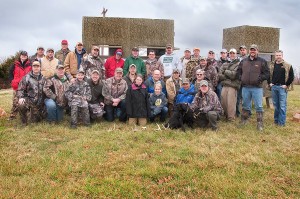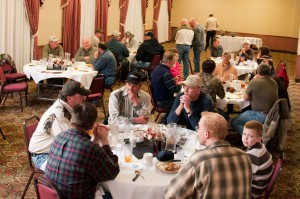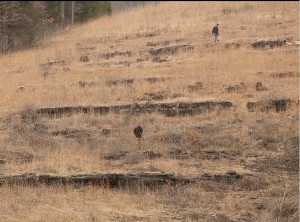Category: Hunting Blog
Timber Management
I’m in the Montgomery, Alabama airport waiting on a flight home. I’ve been working in a privately owned property in south Alabama that is leased to a hunting club. The current tenants have established 100+ acres of food plots, completed an intensive camera survey of the deer herd, and are keeping great harvest records. They are off to a great start!! However, there is much more to deer management than food plots and estimating the demographics of the herd. The property is approximately 2,000 acres. Therefore the food plots only compose approximately five percent of the property. The remaining 95% is just as important for the deer management and hunting programs!!
To address this point, I spent time with the landowner touring the property and addressing the most obvious habitat features that are very unproductive from a wildlife and timber production point of view. In the south, this usually means unmanaged or poorly managed timber stands.
Unfortunately, unproductive timber is common on privately owned forested properties. Forestry practices in the past often dictate the current forest health unless the past forest was totally removed as part of the regeneration program. Typically, the best trees are harvested on private land and the diseased and/or poorly formed trees are left. In any business, if the best stock is removed and the less desirable is left behind for several generations the overall quality decreases substantially. In forestry, this is called high–grading.
Deer herd management always means some degree (usually more than less) of habitat management. Healthy forests usually result in healthy deer. What makes a healthy forest for deer and other species of wildlife? There should be some sunshine reaching the forest floor. There shouldn’t be weedy species, such as sweetgum, filling all the space where more desirable species have been harvested.
Remember that the ax can be one of the best deer management tools – or one of the worst, depending on how and when it is used. It’s always best to use all the tools in the deer management tool box, not just the tractor and a bag of seed. For the deer herd to express its full potential, the entire habitat must be managed, not just a small percentage.
Growing Deer together,
Grant
Late Winter Stress
I’m driving across Kansas today through heavy falling snow. The temperature is thirty degrees and it will get colder tonight. These types of late winter storms cause wildlife, including deer, great stress. Kansas is able to produce mature bucks that express a lot of their antler growth potential year after year despite these harsh conditions. This is mostly because of the large amount of corn and soybeans grown here. Even though I haven’t seen any standing grain there are huge expanses of non-tilled corn and soybean fields that provide enough quality food to allow deer to survive through the winter with reduced stress. These same weather conditions in nonagricultural areas would likely result in hungry deer that don’t have access to a quality food source to alleviate the stress.
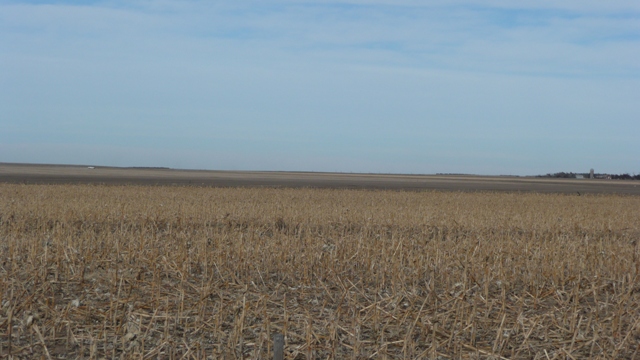 It requires a huge amount of acreage in harvested crops to provide enough grain to carry the deer herd because harvest techniques and modern combines are so efficient that little grain is spilled. The same quality of deer can be produced in nonagricultural areas with much smaller fields of grain if they are not harvested. One acre of grain left standing is probably equal to one hundred or more acres of harvested grain this time of year.
It requires a huge amount of acreage in harvested crops to provide enough grain to carry the deer herd because harvest techniques and modern combines are so efficient that little grain is spilled. The same quality of deer can be produced in nonagricultural areas with much smaller fields of grain if they are not harvested. One acre of grain left standing is probably equal to one hundred or more acres of harvested grain this time of year.
The limiting factor in most of western Kansas is cover. The limiting factor in much of the nonagricultural areas is food. By identifying the limiting factor and providing it in both areas deer managers allow the herd to express most of its potential. Late winter is a great time to take a drive across your property and identify the limiting factor.
Growing Deer together,
Grant
Sign of the Times
There are wildfires in Florida today. Wildfire was part of the natural cycle before Columbus discovered North America. Early explorers reported riding horses for five or more days across where fire had recently burned. They also reported that they traveled 15 miles per day on average while traveling on horseback. That means a fire 75 miles across!! Obviously such fires couldn’t be tolerated today. However, the exclusion of fire from some areas for several years are responsible for the devastating fires that have occurred during the past decade.
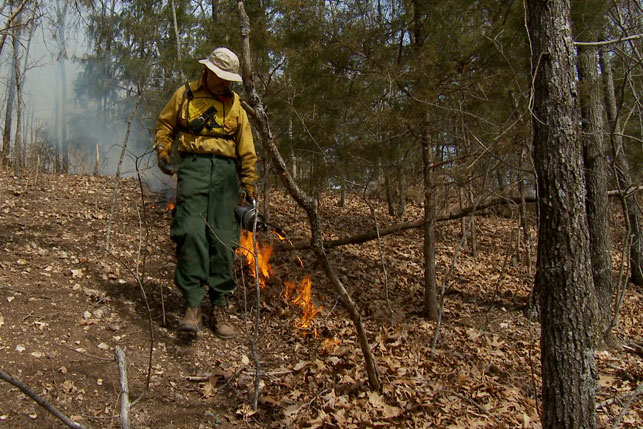
There are several levels of intensity of prescribed fire and fire can be used to complete several different missions such as fuel reduction, habitat improvement, species maintenance, etc. Just like any tool, the more experienced the operator, the more efficient the tool.
There are several sources of education and instruction about using prescribed fire including federal, state, and county agencies along with private contractors. Just like any tool, the more complex the mission the more instruction is required.
I use prescribed fire annually at The Proving Grounds and recommend it as a tool for many of my clients. There are very few habitat types that don’t benefit from or require prescribed fire. Most prescribed fires today are on a much, much smaller scale than what the early explorers encountered. This doesn’t lessen the importance of prescribed fire, it simply requires a bit more planning.
Smokey the Bear was a great campaign at the time. It was basically a message to stop folks from setting wildfires and causing devastating damage. Unfortunately, the message has been frequently misunderstood to mean all fire is bad. Every year I answer questions such as “Doesn’t fire kill all trees?”
Many managers will be using fire this spring throughout the whitetails’ range to improve habitat. When you see smoke or the evidence of a recent fire, remember that Smokey was against wildfire, but he was not against prescribed fire. All tools can be used to do good or do bad. I’ll be using prescribed fire to improve habitat at The Proving Grounds again this spring. If you are unfamiliar with the benefits of prescribed fire, come check out The Proving Grounds and see for yourself.
Growing Deer together,
Grant
Monitor a Herd’s Health by Shed Hunting
Monitoring a deer herd’s health is a critical part of deer management. One of the most enjoyable methods to get an indication of a herd’s health is by going shed hunting! Bucks that hold their antlers through January in most of the whitetails’ range are usually healthy. However, bucks that shed before mid January are usually stressed, injured, or have a disease.
Earlier this week Tracy (my wife) and her shed hunting lab (Crystal) searched several food plots for sheds. The next day Brad drove by one of those plots and saw the right antler from Hidden Valley 8 in plain view. It is very doubtful Tracy and Crystal would have missed that large (62”) shed. That gave me an exact date of when Hidden Valley 8 shed his right side. That’s obviously a rare event to know exactly when a free-ranging buck sheds.
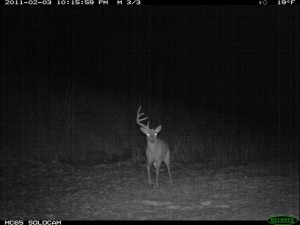 However, much data about when bucks shed can be easily collected by using trail cameras. The average date bucks of each age class shed can easily be calculated. Discovering that an individual buck shed early is not a reason for major concern. However, if a majority of the bucks have shed before January, the herd is experiencing significantly stress, probably due to malnutrition. If most of the bucks still have their antlers through most of January, the herd is probably in good health.
However, much data about when bucks shed can be easily collected by using trail cameras. The average date bucks of each age class shed can easily be calculated. Discovering that an individual buck shed early is not a reason for major concern. However, if a majority of the bucks have shed before January, the herd is experiencing significantly stress, probably due to malnutrition. If most of the bucks still have their antlers through most of January, the herd is probably in good health.
Images of an individual mature buck that shed early are often an indication he has been injured. Closer inspection of the trail camera images may allow determination of the location and extent of the injury.
It is fun to hunt an individual deer, but management of free-ranging herds is best when the entire population is considered. Evidence that a mature buck is injured is disheartening. Evidence that the entire herd is experiencing substantial stress is very concerning and should result in action.
Go shed hunting this week and investigate the health of the local deer herd!
Growing Deer together,
Grant
Crunch Time!
Depending on the latitude and winter conditions where you manage deer, late February and March are usually crunch time for deer. Quality native food resources are usually depleted and new growth hasn’t started yet. If your management goal is to allow deer to express their full genetic potential, it is critical to ensure deer (and other critters) have access to quality forage and grain.
Standing corn is a great crop this time of year!! The ear of many modern varieties of corn tips down when it’s ripe. 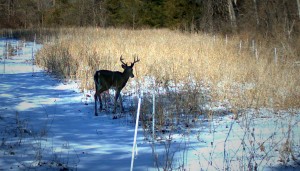 The husk then sheds moisture from the grain and prevents mold from developing. There’s not many less expensive ways to provide energy-rich corn for deer than growing it and leaving it standing. The same is true for Eagle Seed forage soybeans. The actual grain is protected from moisture by a pod.
The husk then sheds moisture from the grain and prevents mold from developing. There’s not many less expensive ways to provide energy-rich corn for deer than growing it and leaving it standing. The same is true for Eagle Seed forage soybeans. The actual grain is protected from moisture by a pod.
Throughout most of the whitetails’ range there is no forage growing during late winter. Standing corn and soybeans provide high quality food during a critical stress period! One reason why deer in the Midwest express more of their antler growth potential than in most areas is the availability of spilled grain in the production corn and bean fields. Although not much grain is left standing, a small percent of spilled grain adds up given the vast acreage of harvested grain.
Would you like to have Midwest quality deer at your hunting area? Then make sure the deer at your hunting area have access to standing corn or soybeans during crunch time!
Growing Deer together,
Grant
Thoughts of Shed Antlers…
It reached 72 degrees at The Proving Grounds today. With warm weather comes pleasant thoughts of shed hunting. I found myself thinking back to last year, everyone had a great time – myself included. Thanks to everyone who was able to come and make it a great day!
If you’d like a chance to discuss management strategies and look for some sheds we’d love to have you join us for our 2nd Annual Shed Hunt. Discussing what works and what doesn’t with other whitetail enthusiasts is always the highlight for me. The knowledge gained from these conversations can positively impact the outcome of our habitat management for years to come. I hope to see you then!
Growing Deer together,
Grant
Crunch Time
This is a great time of year for deer managers! There are usually some days with beautiful weather that makes us think about spring. It’s a great time to shed hunt as most of the mature bucks have dropped their antlers by now. We are collecting soil samples and ordering seed to prepare for the spring planting season! It truly is a fun time of year to be a deer manager.
However, it’s crunch time for mature bucks. Most mature bucks lose 30% + – of their body weight during the rut. Many of them didn’t have access to quality forage and/or grain to regain that weight. Due to the loss of weight, they’ve had a hard time staying warm. Most of the whitetails’ range has experienced wicked winter weather conditions with deep snow and below normal temperatures during the past month or more. These conditions not only made it tough to stay warm, but made accessing the limited food supply very difficult.
Added to these stresses predators are hungry also. With the ground frozen, they can’t find small rodents easily and often turn to larger prey. Many mature bucks received injuries during the rut and predators probably can detect the scent and or appearance of these injuries.
Given all these factors, it’s no surprise that the mortality rate of mature bucks during late winter can be extremely high. Good management can reduce the mortality rate of mature bucks during the late winter stress period through good habitat management. Making sure there is enough quality forage and grain and that its distribution is such that deer don’t have to travel far from cover to access quality food. Quality cover is another factor that helps mature bucks survive the winter. Thermal protection and areas that limit the effectiveness of predators are critical components of quality deer habitat. Again, cover should be distributed such that all deer don’t have to return to the same area for cover and therefore lead all predators to one location.
There will likely be more sheds to find next year if quality food and cover are provided for deer during crunch time this year.
Growing Deer together,
Grant
State Lines…
Monday I was working for a landowner that has properties along the Kansas and Missouri border in both states. It was a cold day with another storm predicted. I saw several deer, turkeys, and coyotes (15+) while on his properties. Several of the coyotes I observed on the Kansas property were in or around warm season native grass fields that were established specifically to provide sanctuaries for deer and other game species. However, when I inspected these sanctuaries there was very little deer sign. I didn’t see any other forms of cover on the neighboring properties.
I was puzzled as it was very cold and 8+ inches of snow had accumulated. The native grass appeared to be the best thermal cover in the neighborhood. The remainder was composed of open hardwoods, harvested corn and soybean fields, and cattle pasture.
I then toured his property in Missouri which is just a few miles away. It also has some very large native warm season grass fields, and so do the neighboring properties. I was shocked that on the same day, same amount of snow, same weather conditions, etc., there were gads of deer sign in the native warm season grasses.
I was very puzzled about this observation. During the ride back to the landowner’s house, we discussed this observation. The only plausible theory we formulated is that the coyotes on the Kansas property are intensively hunting the native warm season grass stands as they are the only cover on that farm. Those stands most likely have the highest rodent population for 100’s of acres. Therefore the “sanctuaries” are hunted so much by coyotes that the deer avoid them. However, on the Missouri farm there are “sanctuaries” in many directions. The hunting efforts of coyotes are likely more dispersed there.
It’s just a theory that probably won’t be tested (it easier to remove several of the coyotes from the Kansas farm). However, if it’s correct, then the theory I was taught years ago that if quality cover is present, predators are not a concern is wrong. I’ve recommended establishing stands of native warm season grasses to be used as sanctuaries for deer in many states and have never known one to be avoided by deer. However, coyote populations were not as high years ago as they are now throughout most of the whitetails’ range.
Have you ever known deer to avoid an established native warm season grass stand during the winter?
Growing Deer (and learning) together,
Grant
Stress
I’m looking out my window at snow that has been on the ground for days. The same scene is visible today throughout much of the whitetails’ range. Snow alone is not necessarily that stressful to deer in the Northeast, Midwest, and West. However, extended periods of snow, ice, and below normal temperatures do cause extreme stress on deer and other forms of wildlife. Like us, deer generate their own heat. Their winter coat was created with the ability to make their hair erect to trap air as insulation when they are cold or lay flat and let warm air escape when they are warm. However, this system works best when deer are generating heat so it can be trapped.
Digesting high quality food is one way how deer generate body heat. Having access to a high quality diet is why cattle in feed yards can withstand extremely cold temperatures and still gain weight. For deer to express their full potential, it’s important for them to lose minimal weight during the winter, or even better to maintain or gain weight. This is only possible if they have access to a very high quality diet.
When snow and ice cover most of the food resources, deer must expend lots of energy to locate and access good quality food. This is when standing grain such as corn or soybeans really pays huge dividends to deer and other forms of wildlife! Corn grain provides very high amounts of digestible energy and soybean grain provides high amounts of digestible protein and better than average amounts of energy. The oil in soybean grain is very digestible and very high in energy.
Deer are currently facing very stressful conditions throughout much of their range. This will likely impact the antler and fawn production of many herds during 2011. However, the deer that have access to standing grain will most likely experience much less stress and express much more of their antler and fawn production potential during 2011.
What are the deer where you hunt and/or manage eating today?
Growing Deer together,
Grant
Harvesting Mature Bucks
I have a few Reconyx images of bucks at The Proving Grounds that have already shed their antlers. Typically, the better the health of the buck the longer into winter they will hold their antlers, so I like seeing mature bucks in February and March still with antlers. Trail camera images from this time of year provide a simple index of deer herd health from year to year when comparing the dates when most bucks have shed their antlers. That’s the management side of those images.
The pure hunter side of me asked why wasn’t I able to see those bucks on the hoof during season? What do I need to change about my hunting techniques to observe and harvest these mature bucks during the fall archery and/or firearms season? Looking back, it’s extremely obvious to me that it’s easier to produce mature bucks than it is to harvest mature bucks. This is true on my land, and most of my clients’ properties.
So how can I improve mine and my clients’ opportunities to observe and harvest mature bucks? First mature bucks must be present. Second, after studying my habitats and the habitats of other hunters, I’m convinced one of the most overlooked techniques for harvesting mature bucks on a regular basis is simply making the commitment to approach the stand, blind, etc., in a way that doesn’t alert deer in the area to the presence of the hunter. This may be the least glamorous and most difficult task of the hunt. Stalking the stand while controlling scent as much as possible and hunting during a favorable wind yielded my cameraman and me three mature bucks this year.
I’ll be writing more about harvesting mature bucks during 2011 and displaying those techniques this fall. Most folks can produce mature bucks. However, there’s still a huge gap between the amount of folks producing and those harvesting mature bucks on a consistent basis. I want to be counted amount those that regularly harvest mature bucks. How about you?
Growing Deer together,
Grant



